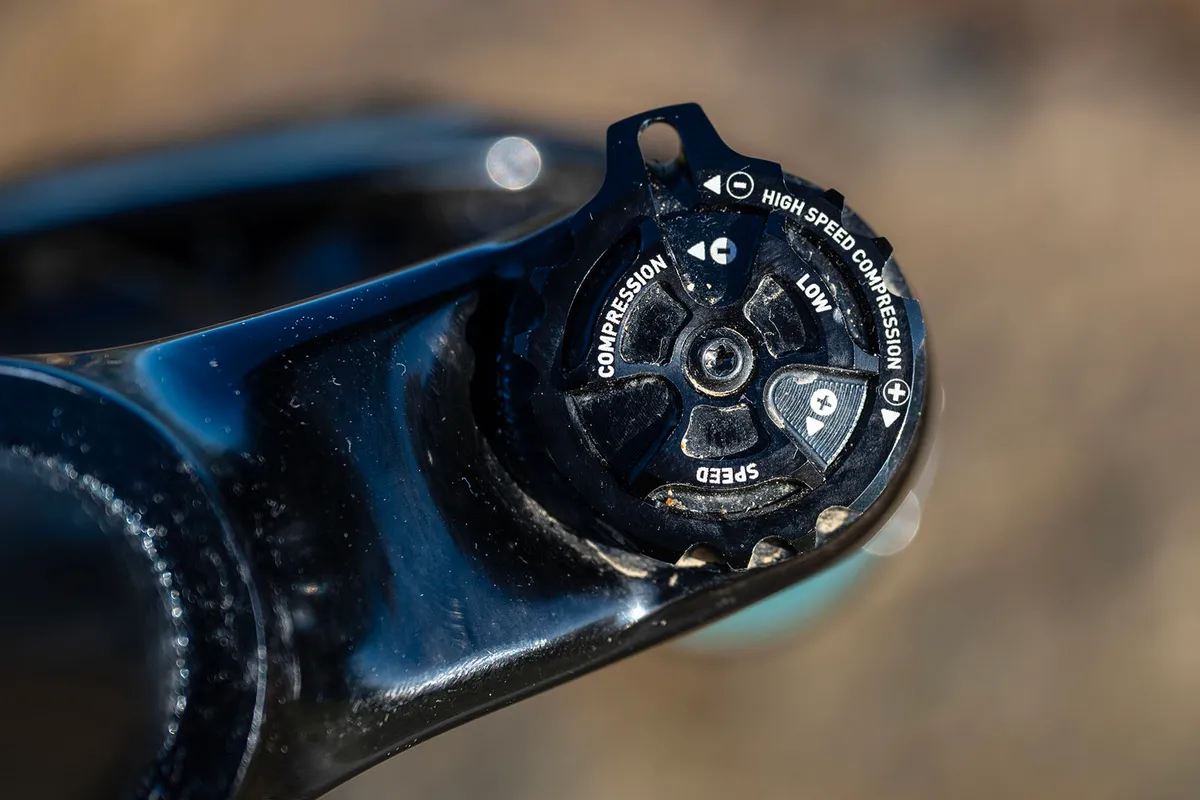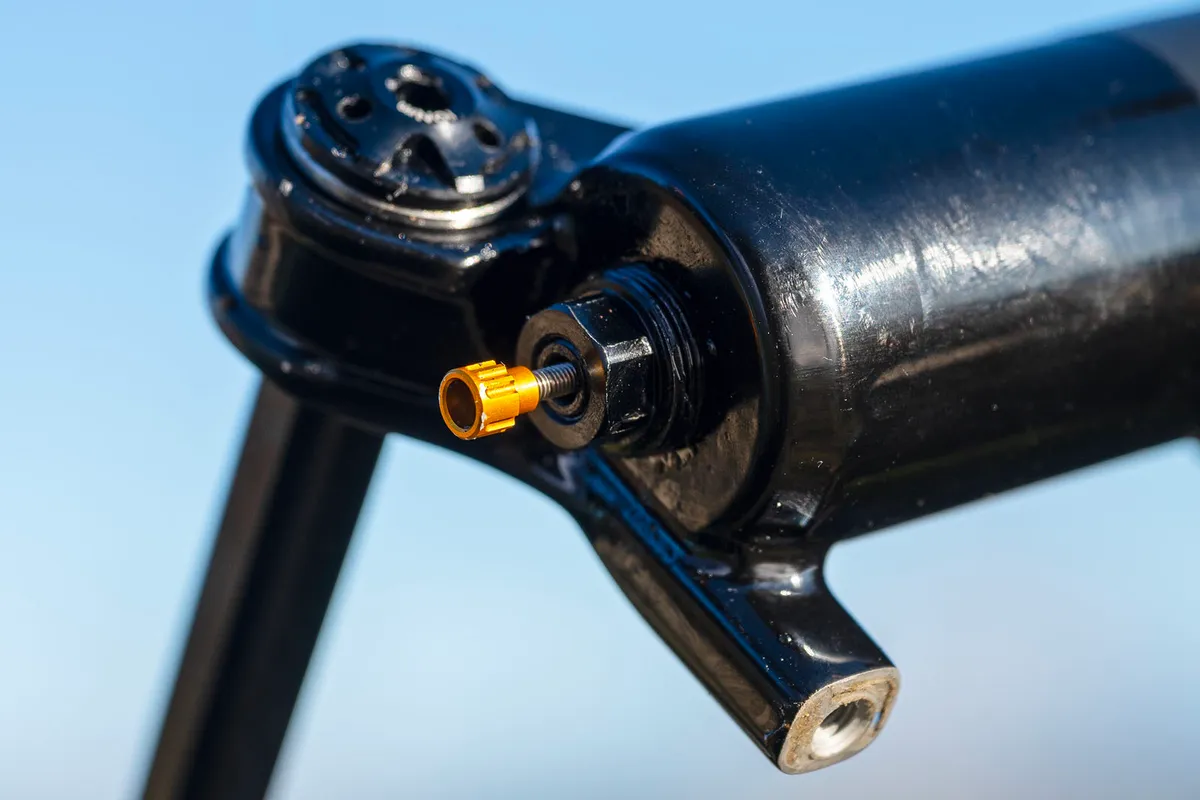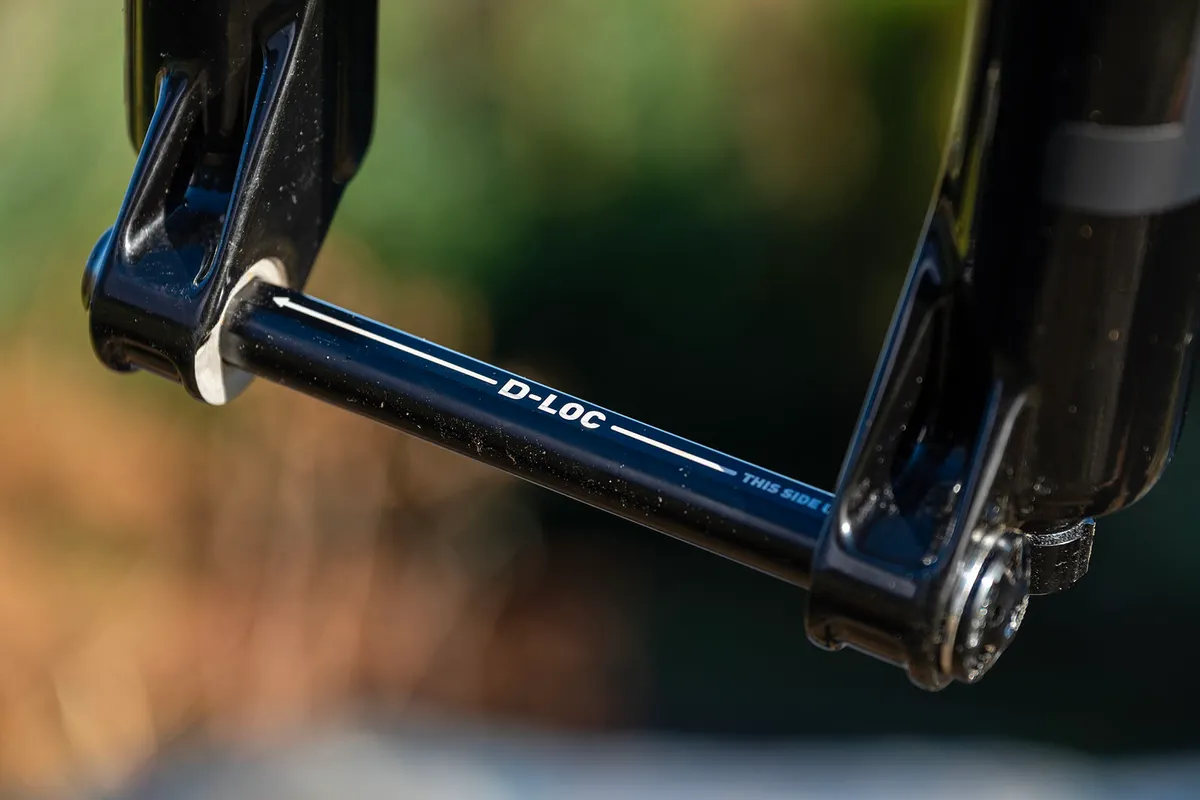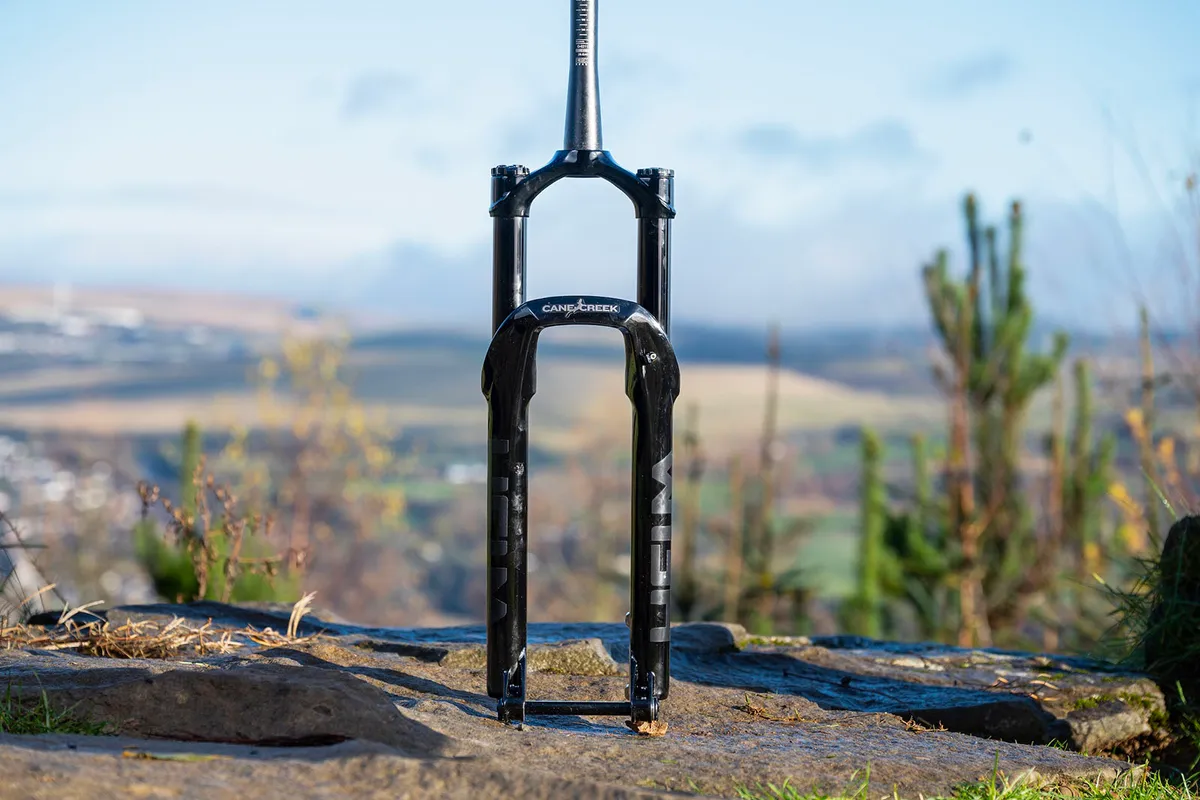Sitting on the line between enduro and all-mountain forks, the latest Helm has seen plenty of updates over its predecessor to maintain its place as a performance product.
The Cane Creek Helm MkII keeps its slender silhouette with its 35mm stanchions. Travel is internally adjustable from 130mm to 160mm.
So, while on the outside it might not have the stature to compete with a RockShox ZEB, for example, it's the performance on the trail that really counts.
Cane Creek Helm MkII Air details and specifications

One feature that sets Cane Creek apart from the big OEM brands such as Fox and RockShox is their products are hand-built at their North Carolina facility by Cane Creek suspension technicians.
The Helm MkII's damper features externally adjustable high- and low-speed compression and low-speed rebound damping. The valves and shims are contained in a sealed cartridge that uses an expandable bladder to deal with oil displacement.
To help increase the sensitivity of the fork, Cane Creek uses 2.5-weight Motorex oil. The oil's lower viscosity should enable it to flow more easily through the updated compression and mid-valve circuits.
An SKF oil seal head rounds out the list of updates to the damper, and should provide a more supple ride on the trail compared to the old fork. The lowers also use SKF wiper seals to further minimise friction and improve sensitivity.
The air spring has seen several updates too. Cane Creek's Double Air spring uses a negative chamber that needs to be manually equalised with the positive chamber.
This gives you a chance to fine-tune the negative pressure compared to the positive, to further improve the suppleness of the initial travel.
However, be warned this could reduce overall fork travel if the negative air spring pressure is too high relative to the positive spring pressure, because this can compress the positive spring until the pressures equalise.
You first add air to the positive chamber via a valve on the top of the fork, then equalise by pressing a valve underneath the fork. This takes a little longer to set up than other forks, but it isn't a chore.
Cane Creek has also increased the size of the air chambers, so they use lower pressures. Plus, in order to minimise friction in the spring, the brand developed a new piston to help it slide more freely.
Progression is tuned by Cane Creek's Indexed Air Volume Adjustment. This self-contained design utilises a piston attached to an aluminium rod with a wing nut.
Loosening the wing nut enables you to slide the piston up or down eight indexed positions on the aluminium rod to set the volume of the positive air chamber.
Setting the piston lower down the rod gives you less volume and a more progressive spring.
The chassis uses Cane Creek's unique D-Loc thru-axle. The D-shaped profile means the axle can’t rotate in the lowers, which is claimed to improve stiffness.
It's available in 27.5in and 29in versions, with 44mm offset (27.5in and 29in) and 51mm offset (29in only). The 160mm, 29in, 44mm-offset test fork I tested weighed in at a light 2.08kg.
Cane Creek Helm MkII Air performance

Cane Creek Helm MkII Air setup
The Helm MkII was tested alongside other 170mm forks, even though the travel maxes out at 160mm. The forks were subjected to the same abuse around BikePark Wales and natural off-piste trails in the South West of England. This gave a good mix of high-speed bike park trails and steeper, more natural tech.
The setup process is more involved than other forks because you manually equalise the negative chamber. There are some broad setup instructions, but it takes a little time to find the sweet spot.
Cane Creek advises initiallly using air pressures of 30 to 40 per cent of your body weight (in lb) in psi. For my 76kg (168lb), I initially inflated the main spring to 59psi (35 per cent body weight). Equalising the negative chamber drops this pressure slightly.
Sag was too low, and the fork too soft. I increased the pressure to 66psi (39 per cent body weight), giving me the 20 per cent sag I was looking for.
I measured the positive chamber after the pressure had dropped to 63.5psi, once the negative chamber was equalised.
This meant I ended up with the volume adjuster on position two of eight, so very linear, because I found the support from the Helm MkII ample for me.
I ran the high-speed compression fully open out of a possible 10 clicks of adjustment. The low-speed compression was also left wide open from 12 possible positions. I set low-speed rebound at eight clicks from closed out of nine.
On the trail
Just because it's small in size, you shouldn't underestimate the performance of the Helm MkII Air. It takes a little figuring out to set up, but once you get it there, it's an impressive piece of kit.
The fork is wonderfully supple through the initial part of its travel, giving it a ride that takes a lot of sting and buzz out of the trail. Rumbling along small, high-frequency bumps, the Helm Mk II is composed and smooth, ironing out imperfections with impressive ease.
This is ideal for those red runs at bike parks and trail centres that give you a constant buzz but no significant impacts.
Deeper into the mid-stroke, the Helm feels as though it relies on the spring for support more than the damping. This gives a very plush ride, where there isn't any harshness fed to the rider.
It doesn't have the most supportive mid-stroke, but there's a good range of low-speed compression damping if you want to wind it on and keep it propped up a little better.
You'll sacrifice a little of the sensitivity, though. Through repeated bumps, the fork is composed and not easily rattled.
It can recover well, although it might not be fast enough for lighter riders – I was very near the end of the rebound damping limit for my 76kg. Heavier riders shouldn't have any issues.

When riding rougher trails littered with roots and rocks, the Helm's active and plush feel really boosted confidence. It provided tons of traction through roots and slippery rocks and held speed well over technical terrain.
Bigger hits were dealt with comfortably, and there weren't any harsh spikes. Hitting compressions and landing drops, progression built consistently through the travel, giving a predictable ride.
Having so many options to set the ramp-up, with eight positions, is nice, but more options mean more time trying to figure out what works. I found progression was good without having to reduce the air volume significantly.
As for its smaller size, the 35mm stanchions are not underwhelming. The Cane Creek has plenty of accuracy in its handling and can easily be placed where you want your front tyre to be. I didn't notice any significant flex.
It tracked the ground well on different cambers, and I didn't get bounced offline or find my front wheel not going where I wanted.
I was impressed by the Helm MkII Air, but it would be good to be able to try a longer-travel version.
How does the Cane Creek Helm MkII Air compare to Formula Selva R?

Both of these forks are top-of-the-line models for their respective brands. Both use 35mm stanchions, so how do they compare on the trail?
Each fork is incredibly supple off the top, partly because the negative springs in each air spring can be pressurised manually to suit your preferences.
This means the Selva R and Helm MkII Air are impressive at finding traction through turns and reducing buzz through the handlebars over chattery trails.
What sets the Selva R apart is the customisable damping. This enables you to fine-tune the fork to best suit your preferred riding style.
While the Cane Creek is very good at smoothing out bigger bumps and providing mid-stroke comfort, you only have the damping adjustments to obtain your preferred setup without getting the valving custom-tuned.
The Cane Creek has more options to fine-tune progression, with its eight-position Indexed Air Volume Adjustment. However, you could cut Formula's Neopos volume spacer to any size to suit your needs.
The Formula offers more performance on the trail. Its balance of sensitivity, support and customisation takes a lot of work to beat.
Cane Creek Helm MkII Air bottom line

Cane Creek's Helm MkII Air takes on the leading brands and holds its own. The setup process is a little more time-consuming, but once you've got the fork feeling how you want, it feels impressive.
Stiction is minimal, and the fork is very sensitive in the beginning stroke. The Helm MkII moves into its mid-stroke travel easily, but has a smooth progression deeper in the stroke, giving a very comfortable ride. Damping adjustments are usable, but the rebound may need to be faster for lighter riders.
If you're looking for an alternative to Fox and RockShox, and the dimensions of the fork suit your needs, the Helm MkII Air is worth strong consideration.
How we tested
The best mountain bike suspension forks are a pricey upgrade, but are one of the most important parts of a bike. They influence performance greatly, contributing to handling, comfort and control.
In addition, forks are one of the first big upgrades riders buy, so picking the right one is essential.
We tested forks that cover a wide range of price points.
The forks were put through their paces on both the black and rough red trails at BikePark Wales, repeating laps to make testing as consistent as possible.
Forks on test
- Fox 38 Performance Elite review
- DVO ONYX SC D1
- EXT ERA V2
- RockShox ZEB Select review
- Cane Creek Helm MkII
- Manitou Mezza Expert
- Formula Selva R
Product
| Brand | cane_creek |
| Price | 1100.00 GBP |
| Weight | 2.0900, KILOGRAM () - |
Features
| br_spring | air |
| br_lockout | no |
| br_wheelSize | 29in_700c |
| br_axle | 110x15mm D-Loc bolt-thru |
| br_damperAdjust | External low and high-speed compression, low-speed rebound |
| br_offset | 51.0000 |
| br_offset | MILLIMETER |
| br_travel | 160.0000 |
| br_travel | MILLIMETER |
| Features | Wheel size: 27.5in +/29in, 27.5in Offset: 44mm (27.5in/29in), 51mm (29in) Travel: 130mm – 160mm |
